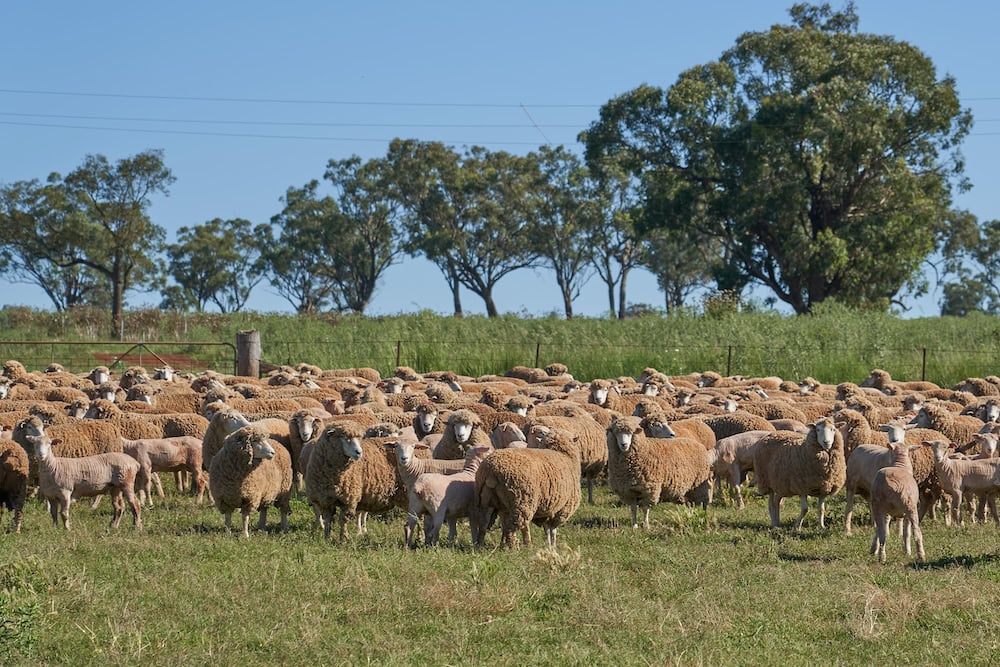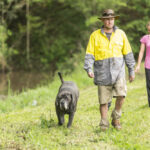When Australians were forced to close their doors on the outside world and isolate themselves…
The Sheepmeat industry: tales to tell

Last year was the most tumultuous year on record for agriculture in NSW and no sector has been left unchanged. Some, such as egg farmers, have enjoyed record year-on-year spikes in sales, while others, such as wool farmers, have seen demand and prices for their produce slashed in half.
The sheepmeat industry, however, is a sector being pulled in many different directions because of COVID-19-related travel restrictions, lockdowns and the global economic recession.

Australia has the second-largest sheepmeat industry in the world, and is the third-largest live sheep exporter in the world. But a sudden plunge in sales to China last March, which previously consumed 39 per cent of Australian sheepmeat, and the shutdown of the airlines and cruise industries and as well many restaurants abroad, left the sector reeling. Within the space of three months, the number of sheep slaughtered for lamb dropped 12 per cent while the number slaughtered for mutton had dropped 26 per cent, according to the Australian Bureau of Statistics.
The after-effects of the 2019 drought, which the Bureau of Meteorology declared as the hottest and driest year on record, have also caused dramatic change. In 2017-2018, there were 70.6 million head of sheep in Australia, according to the ABS. But skyrocketing feed prices forced sheep farmers to de-stock, while the bushfire crisis tested their resilience. Members of the NSW Farmers Sheep Meat Committee estimate the number to now be just over 60 million – the smallest flock size in more than a century.
To get an understanding of how these seismic developments will shape the sheepmeat sector in 2021, we share the stories of four industry stalwarts, warts and all.

Sheepmeat links
“As far as the sheepmeat goes, we’re one of the largest exporters in the world,” says Roger Fletcher, director of Fletcher International Exports in Dubbo, which accounts for a quarter of Australia’s sheepmeat exports.
“We established a dozen new markets – we now go to more countries than the beef guys – so shipping is vital to our business. That’s why what happened last September when wharfies in Sydney went on strike because they wanted a $40,000 wage increase over four years was so unfair to the rest of Australia. We do all the work, truck the sheep in, put the products together in boxes, and all they have to do is press a button to drop them on a ship.
“But that’s just one link in our business, and every link is just as important as the last,” Fletcher says. “We have to keep our quality assurances up and the same goes for farmers. You need to prepare for drought, that is vital, and do what you do best with your land because a farmer in New England is not a farmer in Moree. Don’t listen to consultants. If you are good at rearing ewes, focus on that. If you have the feed to deliver finished lambs to abattoirs, do that.
“I think the future of the sheepmeat industry looks good. The airlines and cruise ships that were the major buyers of our better quality lamb are gone but they will come back with a vengeance. Same thing with wool.”

Price drives in the sheepmeat industry
“What happened with Australian sheepmeat last year was unprecedented,” says Ian Mccoll, a board member of Sheep Producers Australia as well and the NSW Farmers Sheepmeats Committee who runs a mixed enterprise farm in Cowra. “But I’m not talking about Covid-19. I’m talking about the effects of the drought and the best Spring rains we had seen in more than five years.”
“Late last year, farmers were trying to take advantage of the abundance of pasture by buying lots of stock, but there wasn’t much supply. Those two forces working against each drove up prices at breeder sales by 50 per cent to 100 per cent. That has driven the amount of money farmers need to go into sheepmeat production to the highest point I’d seen in my lifetime, so we have to be a lot more professional to survive.
“We’re also entering a new phase in the market where customers are requiring more accountability and transparency for our products. I’m not talking about mutton. India and China will always buy mutton; it’s a staple part of their diet. I’m talking about lamb, which is a premium product. Farmers need to acknowledge that by taking a greater level of ownership of their lamb by forming closer relationships with people in the supply chain to get a better understanding of what customers actually want.
“In the UK, they’re putting edible data dots on meat that consumers can read with their smartphones to learn about its providence and even see a photo of the farm where it comes from. They’re no longer just buying a piece of meat. They’re investing in their health and wellbeing, and they want reassurance they’re making the right choice.”

Tables are turning
“Last year’s drought was the hardest thing I’ve ever experienced as a farmer, much harder than when sheepmeat sales fell off a cliff last March,” says Chris Kemp, a grazier at Merriwa in the Upper Hunter Region of NSW.
“Before we had 200 cattle. Now we have 30. At least our sheep were able to pay their feed bill though we still had to reduce their numbers by a third.
“The rain changed everything and by the second half of the year, things started looking up. At the same time, we were pretty lucky that with the lockdowns, social distancing resulted in people spending much more time at home and cooking for themselves, and so the domestic market really picked up and we were able to move more sheepmeat through retail outlets than any time in the past five years. Everyone had to learn to cook again instead of going to restaurants and getting takeaway every night.
“When you live on the land, you forget about how easy it is for people in the city to just whiz down the street for a good square meal. But farmers don’t have that luxury. We have to come home and cook every night. Either that or heat up a can of baked beans.
“The biggest challenge for this year will be what happens if a vaccine arrives early and COVID-19 ends. The tables will turn and farmers won’t be able to keep up with supply because of small sheep numbers. That’s why I’m trying to get my sheep enterprise running at full capacity again. I’m pushing as hard as I can.”

A challenging market
“Several factors were working in favour of sheepmeat farmers in the second part of last year and one of them was restocking after the drought,” says James Jackson, a mixed enterprise farmer in Guyra in the New England Region and President of NSW Farmers.
“Sheep have a reasonably high reproductive rate, especially breeds used for sheepmeat, so farmers can quickly rebuild flocks. Once the drought broke across NSW, things got very buoyant and farmers became very keen to put more kilograms on their sheep. That created extraordinary demand for cross-breed ewes of up $300 to $400 per head against a 40 per cent drop in sheepmeat prices.
“Why did prices fall last year? Well, 60 per cent of sheep in NSW are butchered in Victoria because they have larger abattoir capacities than us. But a lot of those abattoirs closed down during the lockdowns, which created a lack of processing facilities and that drove down the slaughter price. So we had a two-pronged effect and that caused a huge disconnect between saleyard prices and slaughter prices.
“Another factor playing into the market,” Jackson says, “is African swine fever and the devastating effect it had on pig numbers in China. That’s put a lot of pressure on the global protein market as people look for other sources of protein. After pork, the Chinese prefer fish as their source of protein. Beef is next and sheepmeat is not far off, especially in the north of China. So even though sheepmeat and pork aren’t directly interchangeable, swine fever has certainly given sheepmeat exporters a leg up.”
If you enjoyed this feature, you might like our story on the shearer shortage.








